If you want to compare the International Sleep Products Association Sustainability Conference with a football game, it’s safe to say its goal is to move the ball down the field.
In this case, the ball is movement toward a more circular economy. To achieve that, ISPA brings together sleep products suppliers and manufacturers, sustainability professionals and recyclers to discuss recycling challenges, share beneficial sustainability practices and return to work feeling inspired and more informed. This year’s ISPA Sustainability Conference was held Sept. 10-11 in Atlanta.
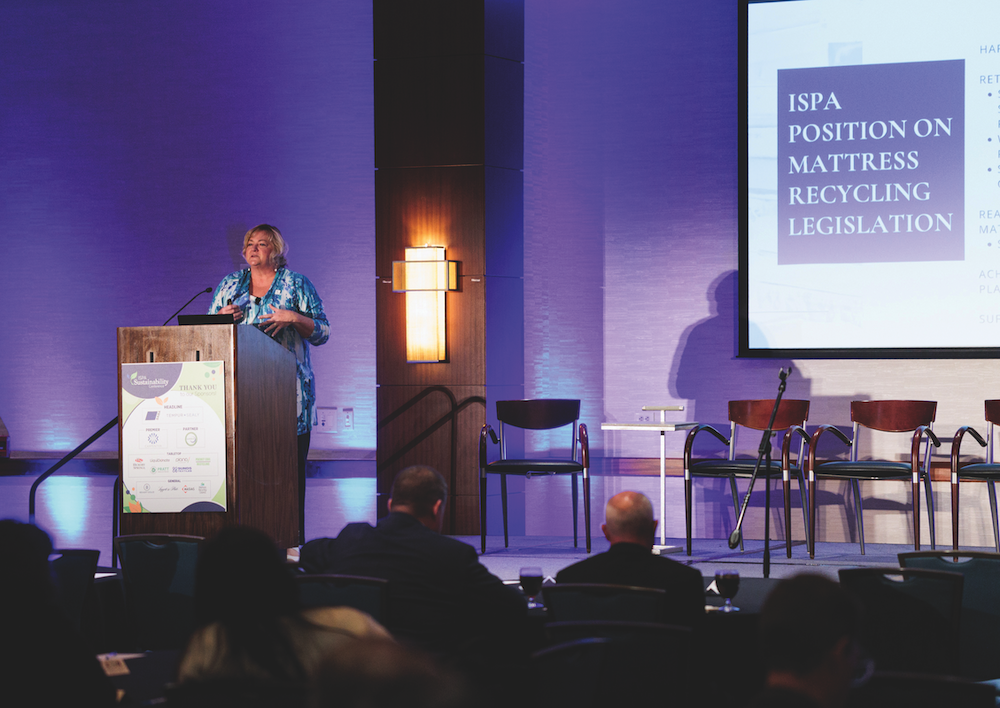
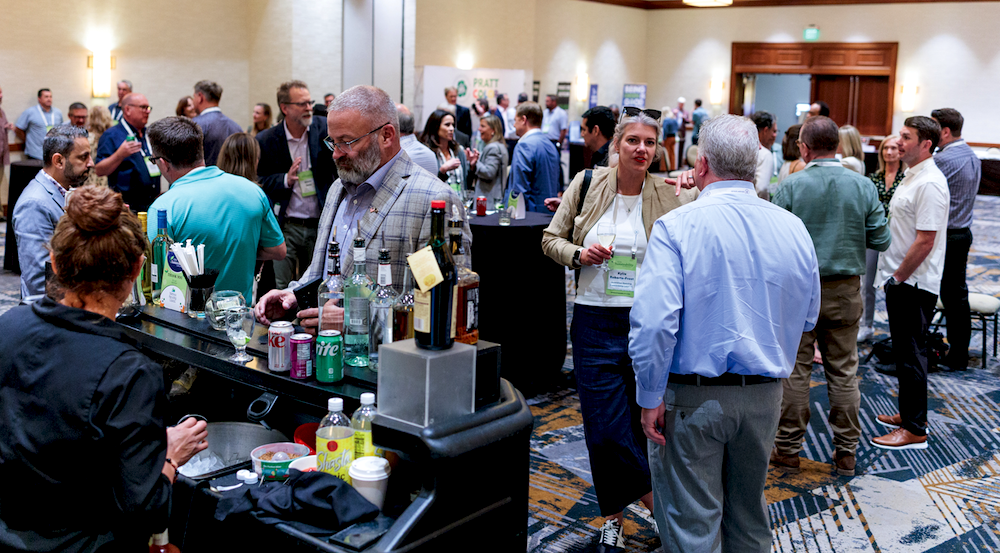
The two-day conference explored everything from tracking greenhouse gas emissions to understanding investors’ priorities around sustainability. A highlight, as always, was the Mattress Recycling Council’s Workgroup on Circular Design. Attendees separated into breakout groups to discuss the following topics: design for disassembly; waste reduction across the value chain; circular fabrication materials; reducing lifecycle carbon emissions; and downstream communications among retailers, consumers and recyclers.
Tackling Mattress Recycling Challenges and Circular Design
One element of sustainability within the sleep products industry is mattress recycling. But it doesn’t come without its challenges.
To demonstrate the complexity with mattress disassembly, Matt Young, president of Sustainable Material LLC, took a mattress apart on stage. Carpenter Co. created the mattress and BekaertDeslee designed the cover especially for the conference. Visit BedTimesMagazine on Instagram or Facebook to see Young in action in a series of video clips (Bit.ly/4otakPC or Bit.ly/43ugWoN).
Young, along with panel members Michelle Williams, president of Mat Recyclers, and Terry McDonald, director emeritus of St. Vincent de Paul Society Lane County Inc., noted that a lack of uniformity of mattresses is one aspect that makes them difficult to recycle.
“If you look at something like a plastic bottle or a can or even a cardboard box, it’s very simple to deconstruct because it’s obvious what it’s made of and how to separate it into its component parts,” Williams said. “But what you will see (with mattresses) are varieties of covers, different types of foam, numbers of layers, depth of layers, width of layers, types of coils. … When you have all of these different types of mattresses that are structured incredibly differently, it creates a lot of complicated issues for the individual that’s cutting them.”
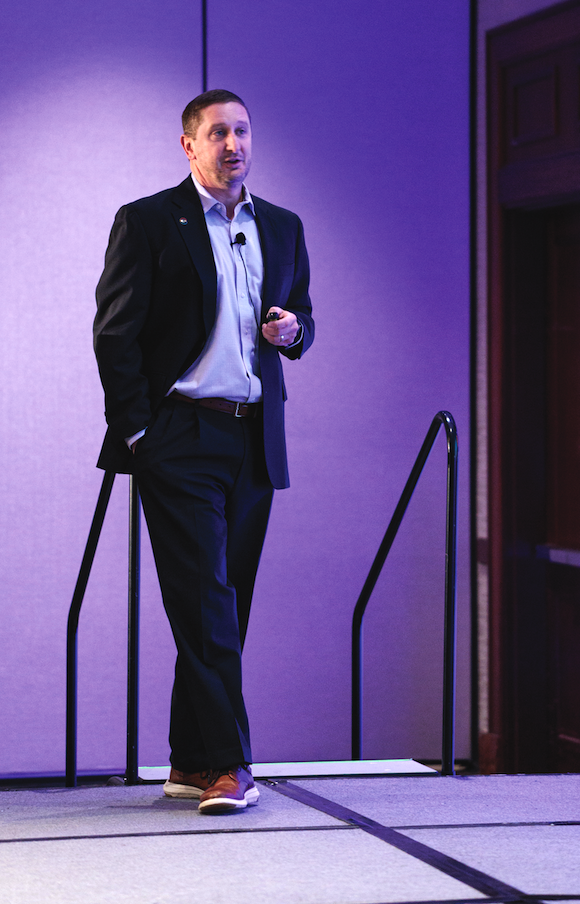
vision to be fully circular.

fellow of sustainability for Ford Motor Co., shares how she helped drive sustainability
forward in the auto industry.
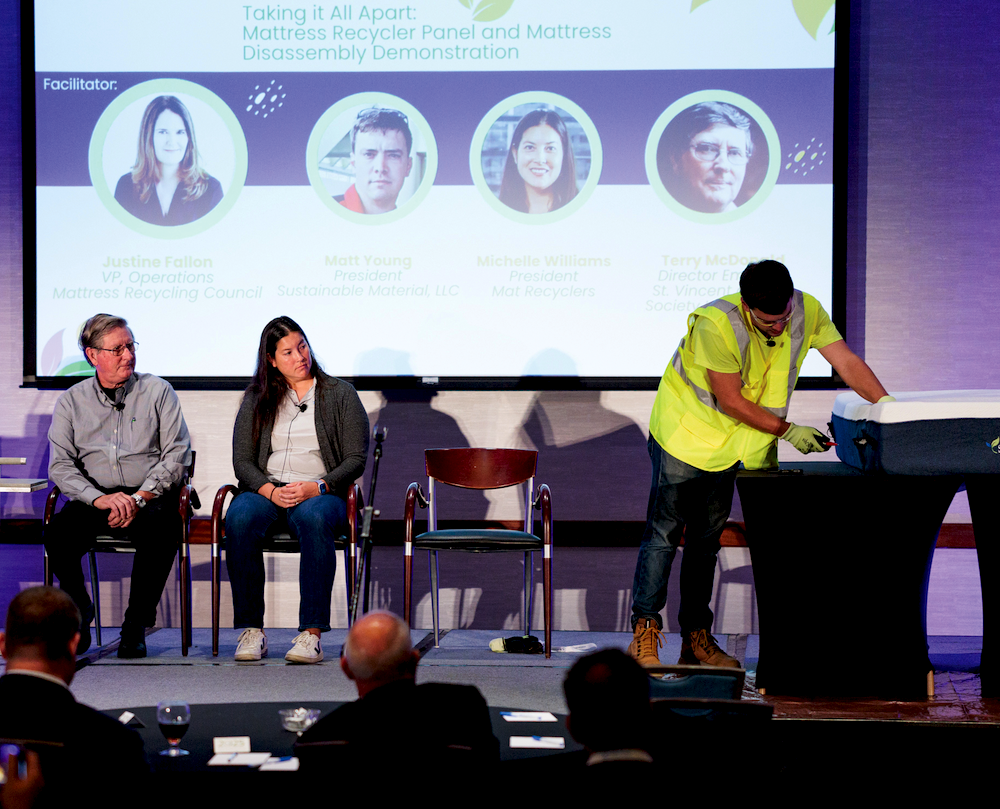
and fellow recyclers Terry McDonald and Michelle Williams, look on.
McDonald called for manufacturers to inform MRC when new components are going into mattresses, so they can pass that message along to recyclers. Fortunately, MRC’s Workgroup on New Materials has been meeting with the industry for years with the goal of informing MRC about materials and technology that are new to market (but not proprietary) to help MRC and recyclers prepare for what is coming.
The conference also explored refurbishment as a sustainable solution for comfort returns.
Emma Reid, director of sustainability for U.K. boxed-bed brand Simba Sleep, and Nick Oettinger, CEO of The Furniture Recycling Group, shared their experience.
Simba, which designs its mattresses to be recyclable, started sending its comfort returns for refurbishment. “We launched it properly on our website in 2022,” Reid said. “We used to do it sort of quietly, but then decided then that we need to be proud that we’re offering this. We need to get rid of that stigma around refurbs and really challenge customers about what they think about it. It’s a major part of our business now.”
The company partnered with The Furniture Recycling Group, which has rejuvenated more than a quarter million mattresses. Oettinger said he started looking at refurbishment when he realized his company was recycling a large amount of barely used materials. (The MRC reports up to 10% of California mattresses that come into recycling facilities would be reusable in their current format.)
The refurbishment process includes checking each mattress for damage, which often can be repaired. Covers are treated in a three-step sanitization system and cores are put through a pressurized chamber for cleaning, Oettinger said. The mattresses are then packaged and returned to Simba for resale.
Reid said these mattresses have become a source of income, and the web page for resale is one of its top 10. When consumers were asked why they purchased a refurbished mattress, 62% cited price and 18% said sustainability. “We’ve had amazing feedback,” Reid said.
Implementing ESG: Emissions Tracking and Investor Priorities
Attendees spent the morning of the first day of the conference learning about greenhouse gases — what they are, how to track them and how to minimize them. Led by Robbie Moon, an associate professor at the Georgia Institute of Technology, this session got into specifics designed for sustainability professionals and organizations looking to strengthen their emission reports and reduction strategies.
Attendees also learned what investors are prioritizing when investing in sustainability within a company. Priyanka Shome, vice president of sustainability for One Rock Capital Partners, and Andrew Prusky, senior vice president and general counsel for FXI, discussed their working relationship over the past few years.
“For every portfolio company, we have someone who’s at the executive level who owns ESG and sustainability,” Shome said. “Because we believe in order for things to happen throughout the organization, there needs to be buy-in from the top.”
“We’ll help put in place environmental policies around waste, around water, etc. Every company within the first hundred days develops sort of an initial sustainability value creation roadmap,” she added.

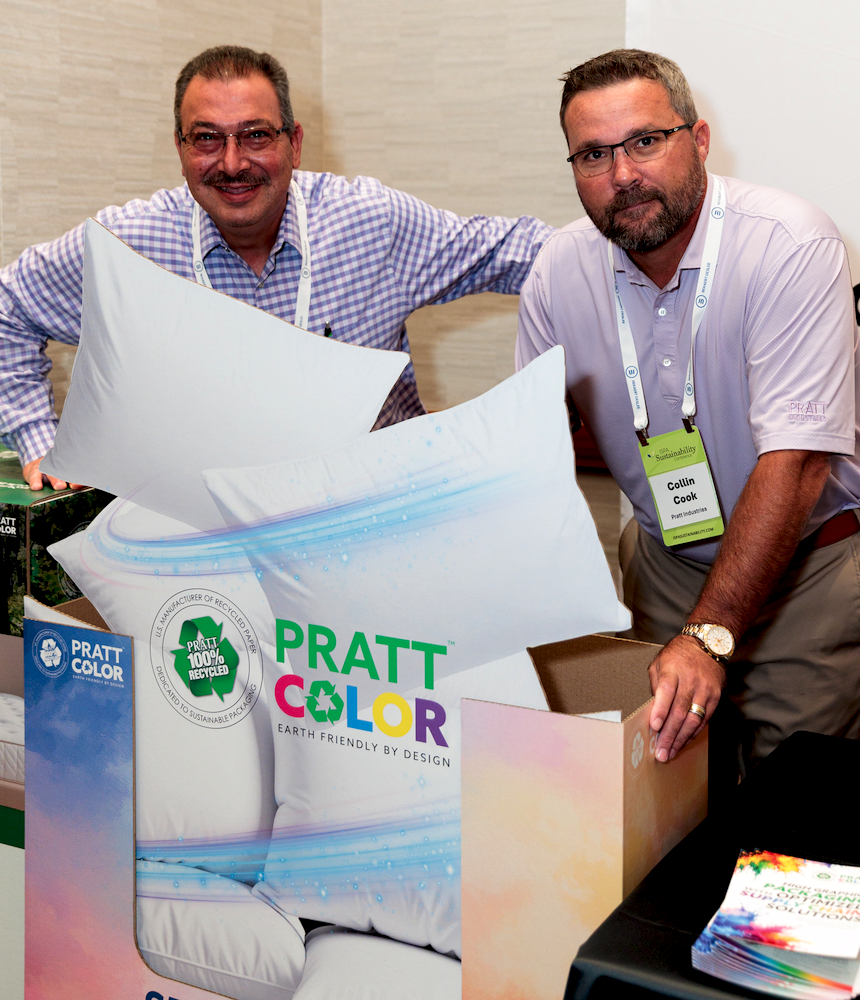
showcase products from Pratt Industries, a recycled packaging manufacturer.
Prusky noted sustainability is embedded into FXI’s cross-functional operations. For example, FXI recently conducted an energy treasure hunt at its most energy intensive site. Plant personnel and those from nearby plants walked the space to identify opportunities to reduce waste and plan how to address those issues.
Shome added: “We find that employees get really excited to be a part of these initiatives and implement these things and make their plants greener. Getting to the level of the plant site and involving the operations managers is where we get the biggest impact in terms of our emissions and in terms of our waste. They’re the people on the ground who have the best ideas.”
Inspiration for Action: Corporate Sustainability Journeys and Consumer Trust
In addition to practical information, the conference also offered a strong dose of inspiration. Tim Thiel, circular economy manager for Covestro, shared its circularity journey.
“Circularity became our mission over the past five to six years. We don’t make single-use products. I like to say we’re a durables company,” he said. “Circular economy is our guiding principle as a company.”
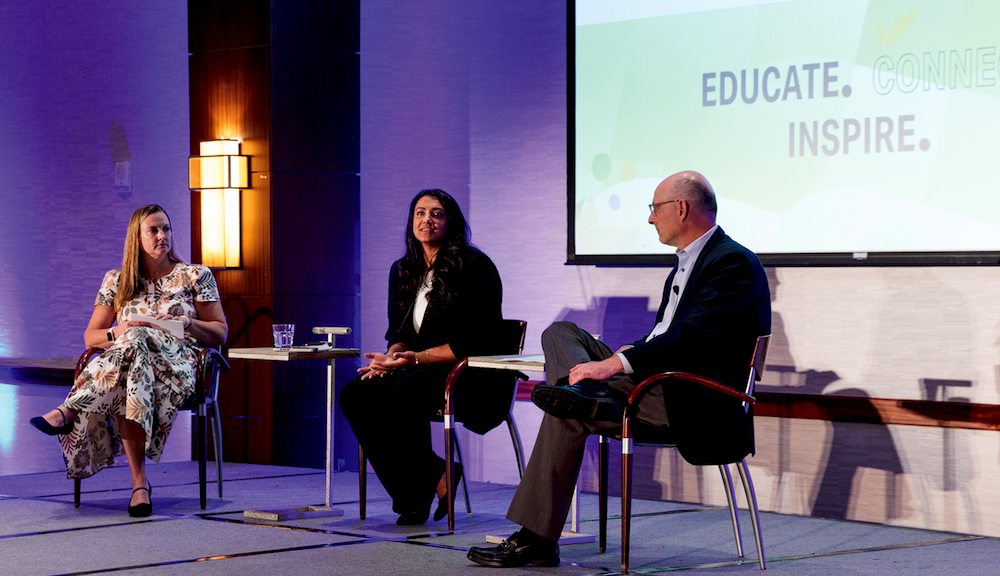
Over the past two to three years, Covestro has made sure that every employee in the company understands sustainability and what the company is doing to achieve its goal of circularity and climate neutrality.
Deborah Mielewski, retired technical fellow of sustainability for Ford Motor Co., acknowledged the road to sustainability is rocky but pointed to a few successes, such as reducing the hole in the ozone layer. “Look for examples to inspire you,” she said.
Her first success was the creation of soy foam that is now used in Ford seats and cushions. That led to using waste powder in 3D printing to create car parts.
Joel Hartter, founder of Parallel Labs, ended the conference with a look at the next frontier of sustainability. Businesses need to be aware of millennial and Gen Z buyers, who value authenticity and trust. “Seventy-three percent are willing to pay more for sustainable products and services. Not because it’s a nice to have, but because they see it as part of brand trust.”
Building Momentum: The Value of Industry Collaboration and Networking
Coming out of the conference, Shaye Hardner, sustainability manager for Worthen Industries, felt encouraged. Her main takeaway: “Commitment to sustainability continues, despite the many uncertainties around us.”
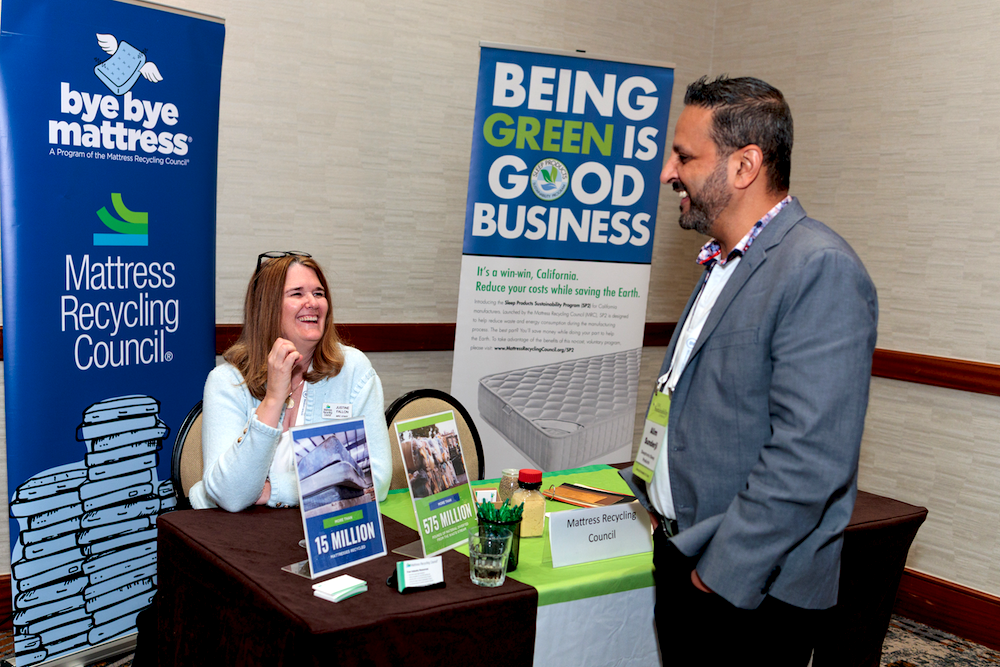
She added that interacting with industry colleagues at the conference was the biggest benefit to her. “I greatly value the opportunity to connect with and learn from thoughtful, inspiring people who are dealing with similar challenges and opportunities,” Hardner said.
Henry McRee, senior account executive for William T. Burnett & Co., who said sustainability is close to his heart, found networking to be one of the most helpful aspects of the conference, as well. “I enjoy the breakout sessions, the opportunity to brainstorm with suppliers, customers, competitors. It’s beneficial.”
He’s attended every conference so far. “And I don’t plan on missing any in the future,” he said.
Jim Turner, CEO of SABA North America, one of the headline sponsors, has also been to every conference. “I’ve never left one without learning something, even if it’s just, what are the trends? What are the challenges of recyclers? What’s the hot topic?” he said. “It generates ideas and creates a sense of urgency.”
Allen Platek, vice president of new product development for Tempur Sealy International, the other headline sponsor, appreciates the participation at ISPA events. “We get a lot more action when we collaborate on things,” he said when introducing Hartter. “We learn from each other. We build on each other’s strengths and walk away better prepared for what’s ahead. For me, it’s just not about my company. It’s about helping strengthen the entire industry, because if this entire industry is strong, we’re all going to thrive.”
Progress in Mattress Recycling
On the first day of the conference, the Mattress Recycling Council provided circularity updates. MRC is a nonprofit organization formed by the mattress industry to operate recycling programs in states with mattress recycling laws. It also conducts research on how to use recycled components that can be sold into end markets.
First the good news — since 2015, more than 100 million pounds of polyurethane foam has been recycled, said Mike O’Donnell, MRC’s chief operating officer. That’s equivalent to filling nearly half of the Mercedes-Benz Stadium in Atlanta. And with more states considering mattress recycling programs in the next few years, that foam output will grow.
Here’s the challenge — recyclers need more secondary markets. Right now, 86% of foam and 100% of quilt materials are sold into markets that make rebond, which is mainly used in carpet pads. Unfortunately, the market for carpet — and therefore carpet pads — is decreasing, dropping almost by half over the past 10 years. In 2015, foam sold from 25 to 40 cents a pound. Today, it sells for less than 10 cents a pound.
Moving forward, MRC is looking into other ways foam can be reused. One potential market is repolyol, which is chemically recycled foam. Another is vitrimer, a reprocessable polymer made from mattress foam which can be used to create products such as synthetic leather, cell phone cases or shoe soles.
MRC is funding foam research projects which has led to developments such as the Oleo sponge. It’s a modified mattress foam that absorbs oil and not a lot of water. It has strong potential in oil spill clean-up applications. MRC is also exploring applications for recycled mattress foam ground to fine powder.
Textiles, including padding, batting, quilt, shoddy, pocketed coils and box spring covers, and other fibers, are another area of interest. Currently, 42.6% of what is thrown away at recycling facilities are textiles.
To generate new concepts and ideas for future research programs, MRC is launching two technical workgroups — one for foam (facilitated by Karl Haider, MRC research consultant) and one for textiles (facilitated by Mike Gallagher, MRC research consultant). These groups will meet three times a year (two virtual meetings, one in-person).






